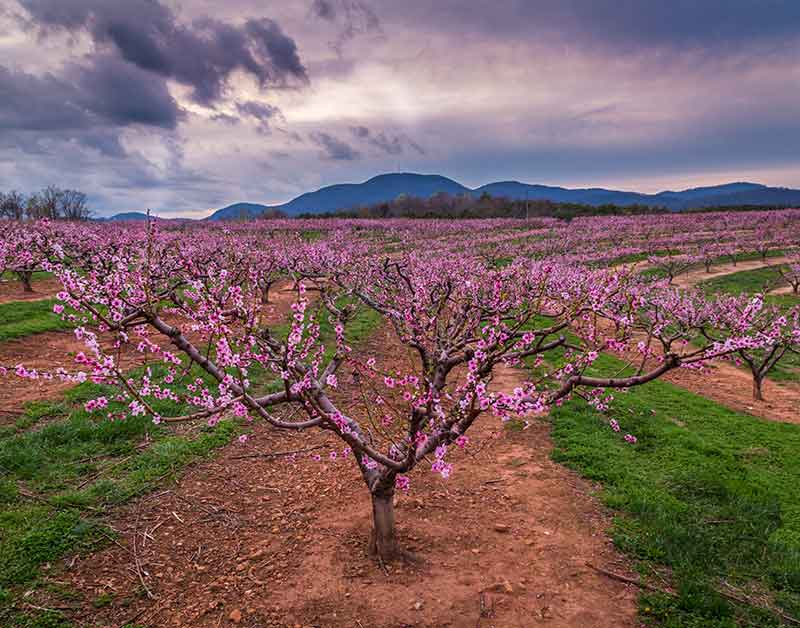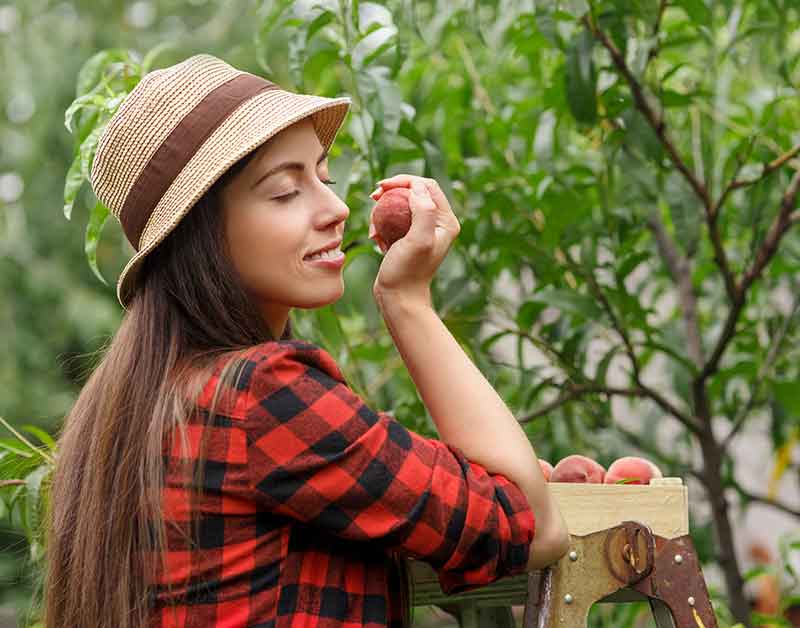How to Grow and Care for a Dwarf Peach Tree
Growing a healthy, productive peach tree is a fruitful adventure. Despite the extra TLC these trees need, one juicy bite of a homegrown peach makes it all worthwhile. With a dwarf peach tree — just 8 to 10 feet tall — you can enjoy beautiful spring blossoms, green foliage and delicious full-size fruit in a manageable size perfect for backyards. Just follow these basics for growing dwarf peach trees and get ready to taste the rewards:
- How to Choose a Dwarf Peach Tree
- Where, When and How to Plant a Peach Tree
- How to Care for a Dwarf Peach Tree
- How to Train, Prune and Thin Peach Trees

Peach trees offer beautiful blossoms as well as fruit.
How to Choose a Dwarf Peach Tree
When choosing a dwarf peach tree for your yard, there are several considerations that stand between you and the fruits of your dreams. Good advice from a local nursery or your local county extension office can make sure all these considerations line up right:- Size – Dwarf peach trees mature to half the size of standard peach trees because they're grown on special roots. Semi-dwarf trees are in between. Nursery-grown peach trees are two varieties in one: a top variety bears fruit, while a bottom variety forms roots. Rootstocks influence hardiness, disease and pest resistance, and mature tree size — but not fruit. Small trees make care easier, but you still harvest up to 3 bushels of full-size peaches each year.1
- Chill hours – Peaches need a period of cold temperatures, called "chill hours," each winter or they don't bear fruit. Different varieties have different chilling needs. A reputable nursery helps ensure the cold in your area matches your peach tree's needs. Warm-climate peach lovers need "low-chill" dwarf peach varieties.
- Fruit type – Known as stone fruits for their stone-like pits, peaches come in freestone and clingstone types that earn their names. Freestone peach flesh separates freely from the pit. Clingstone flesh clings. Though you can grow a peach tree from the pit, you'll wait two to four years to taste it. And your new peach tree won't be small or taste like the parent peach.
- Pollination – Unlike many fruit trees, dwarf peaches don't require cross-pollination with another peach. Honeybees can pollinate peach blossoms with the tree's own pollen. But if your neighbor has a peach nearby, expect bigger, better harvests.
By taking all these things into consideration, you can choose the best peach tree for you.

Peach trees bear fruit on long branches and short spurs.
Where, When and How to Plant a Peach Tree
Choosing the right planting site sets up your dwarf peach tree for health, beauty and peak productivity. Peaches have basic site requirements and planting needs:- Light – Healthy peach tree foliage and abundant fruit need at least eight hours of daily sun. Without that, trees have less fruit, less vigor and greater risk of insect pests and fungal disease.
- Soil – Peach trees demand well-drained soil. Poor drainage leads to less fruit, poor growth and shortened life expectancy. Soil pH near 6.0 to 6.5 is ideal for peaches.2 A simple soil test reveals if you need soil amendments to correct pH or other issues before you plant.
- Timing – Planting time varies depending on your location. Georgia gardeners plant dormant peach trees from December to February.2 Minnesotans plant hardy peaches as soon as spring soil is workable, before warm weather arrives.
- Tree types – Nursery peach trees may come in containers or as "bare root" trees with all soil removed. Follow all pre-planting and planting instructions that come with your tree.
- Planting – Look at the tree trunk and you'll see a bump about 2 inches above the soil line. That's where the dwarfing rootstock and your fruiting variety unite. Dig a hole twice as wide as the roots and just deep enough so the union stays 2 inches above the surrounding soil. Always remove the nursery pots before you plant.
- Finishing – Fill your hole halfway, water thoroughly and treat your peach tree with Pennington Plant Starter to reduce transplant shock. Then finish filling the hole, firm the soil, and water the area thoroughly. Do not fertilize peaches at planting time.

Open-centered, vase-shaped pruning improves peach quality.
How to Care for a Dwarf Peach Tree
Proper care helps your dwarf peach tree stay attractive and productive. Basic care, preventative spraying and pest control are essential to healthy trees and fruits:- Fertilizer – In March or about three weeks after planting, Pennington Rejuvenate Plant Food All-Purpose 4-4-4. Created to work with nature, this fertilizer revitalizes soil with essential plant nutrients and a blend of organic and natural ingredients to improve the soil environment and nourish plants from the inside out. Feed again in May and late July. Follow that same schedule every year of your dwarf peach tree's life. Do not overfertilize — you'll get more leaves and less fruit.
- Water – After your tree's first year, normal rainfall should provide all the water it needs. During the first year, irrigate as needed so your tree gets the equivalent of 1 inch of rain per week. With peaches, too little water is better than too much. Overwatering leads to yellow leaves and peach diseases. Unless your area has extended drought, let nature water established peach trees.
- Timing pest control – Peach trees are prone to fungal diseases that attack foliage and fruits. Plus, several insects like peaches as much as humans do. But spraying peach trees requires proper timing. Peach tree treatments to prevent and control diseases and insects coincide with three times: the dormant season, bud break or after blossom petals fall. To protect pollinators — and the fruit that pollination brings — never spray insecticides until after blossom petals fall.
- Disease control – Fungal diseases attack peach trees regularly, especially during warm, wet years. Stop, control and prevent common peach diseases such as brown rot, peach leaf curl, blossom blight, scab and shothole with Daconil Fungicide Concentrate. Follow label instructions for disease-specific timing, and never apply between fruit formation and harvest.
- Insect control – Major peach tree pests include plum curculio weevils, peach tree borers, Oriental fruit moths and scale insects that burrow into twigs and fruits. Treat peach trees with Sevin Insect Killer Ready To Spray or Sevin Insect Killer Concentrate to kill pests by contact and protect peach trees for up to three months.+ Allow at least 14 days between application and harvest.
Nurturing and protecting your peach tree helps foliage and fruit stay healthy.

When peaches pass the smell test, they're ready to eat.
How to Train, Prune and Thin Peach Trees
Training, pruning and thinning peach trees is essential to peach production. It really isn't complicated, but it does take extra work. Pruning stimulates healthy growth, reduces risks of diseases and pests and helps ensure productive harvests:
- Early training – Peach tree training focuses on creating an open center or vase shape, so maximum light penetrates branches and reaches peach fruit. Nursery-bought peach trees are usually pre-pruned to stimulate open lateral branching at angles similar to outstretched arms or clock hands at 10 and 2.
- Annual pruning – Peaches produce fruit on long branches from the previous year and short branches called spurs. Annual trimming happens during the dormant season, when bare branches reveal the tree's form. Prune to retain the open-vase shape. Remove dead, damaged and low-hanging branches, plus center-blocking upright shoots and the oldest, non-fruiting branches each year.
- Thinning – Left to themselves, peach trees produce more fruit than they can support. Though numerous, the fruits are small and poor. Thinning fruit from dwarf peach tree branches helps ensure larger, top-quality fruit. Three to four weeks after blooming, when fruits measure about 1 inch,3 thin the fruits by hand. Leave one fruit every 6 to 8 inches.
With pruning and thinning, you ensure you'll get better, bigger peaches from your tree.
Depending on your peach varieties, you and your family can start enjoying delicious homegrown peaches from late spring through late summer every year. To harvest peaches, wait until fruits are fully colored — no green allowed — and they detach easily from the tree. Then conduct the final test: If you can smell that delectable peachy smell, it's time to harvest.
By providing your dwarf peach trees with the care they need, you and your friends and family can experience the rewards. At GardenTech, we're here to help you learn and grow, so that all your gardening adventures are as sweet as your peaches.
+Except fire ants, fleas, ticks and mosquitoes
Always read product labels thoroughly and follow instructions, including guidelines for pre-harvest intervals (PHI) and application frequency.
"Always read product labels thoroughly…" GardenTech is a registered trademark of Gulfstream Home & Garden, Inc.
Sevin is a registered trademark of Tessenderlo Kerley, Inc.
Pennington is a registered trademark of Pennington Seed, Inc.
UltraGreen is a registered trademark of Central Garden & Pet Company.
Get Monthly Gardening Advice!





